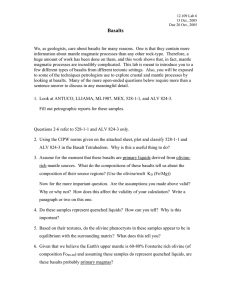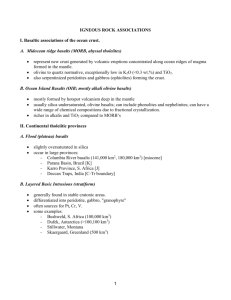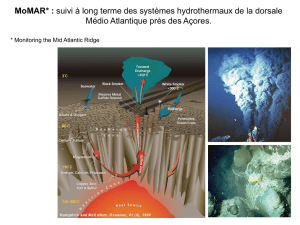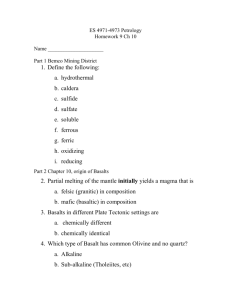VOLCANIC ROCKS FROM THE LUCKY STRIKE CENTRAL VOLCANO,
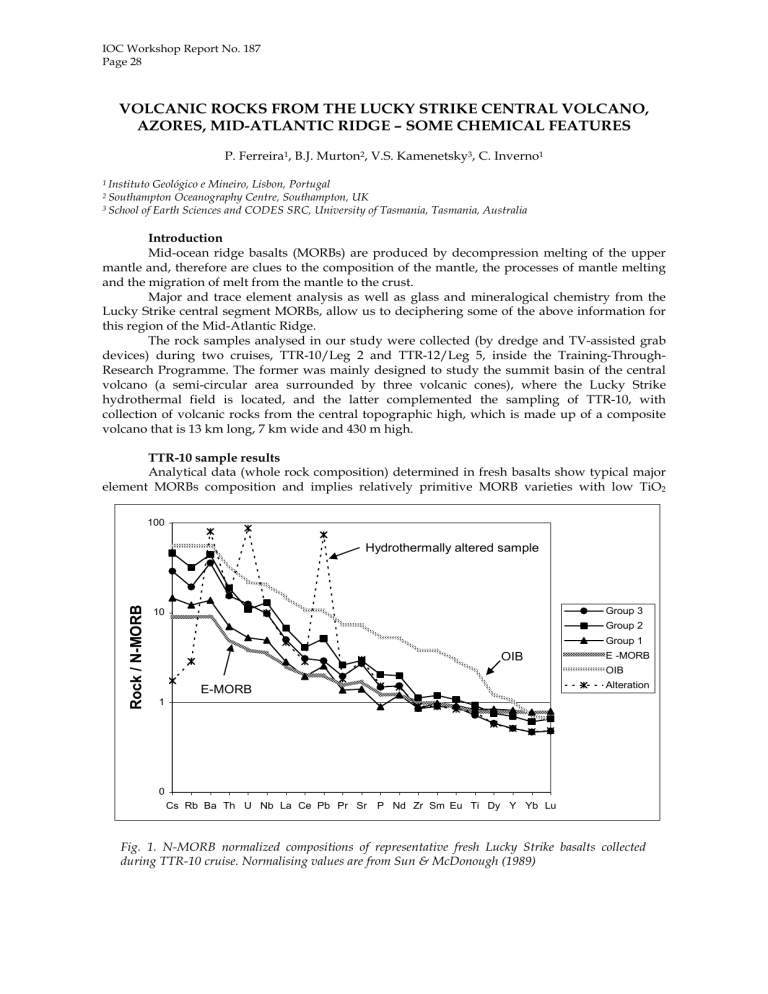
IOC Workshop Report No. 187
Page 28
VOLCANIC ROCKS FROM THE LUCKY STRIKE CENTRAL VOLCANO,
AZORES, MID-ATLANTIC RIDGE – SOME CHEMICAL FEATURES
P. Ferreira 1 , B.J. Murton 2 , V.S. Kamenetsky 3 , C. Inverno 1
1
2
3
Instituto Geológico e Mineiro, Lisbon, Portugal
Southampton Oceanography Centre, Southampton, UK
School of Earth Sciences and CODES SRC, University of Tasmania, Tasmania, Australia
Introduction
Mid-ocean ridge basalts (MORBs) are produced by decompression melting of the upper mantle and, therefore are clues to the composition of the mantle, the processes of mantle melting and the migration of melt from the mantle to the crust.
Major and trace element analysis as well as glass and mineralogical chemistry from the
Lucky Strike central segment MORBs, allow us to deciphering some of the above information for this region of the Mid-Atlantic Ridge.
The rock samples analysed in our study were collected (by dredge and TV-assisted grab devices) during two cruises, TTR-10/Leg 2 and TTR-12/Leg 5, inside the Training-Through-
Research Programme. The former was mainly designed to study the summit basin of the central volcano (a semi-circular area surrounded by three volcanic cones), where the Lucky Strike hydrothermal field is located, and the latter complemented the sampling of TTR-10, with collection of volcanic rocks from the central topographic high, which is made up of a composite volcano that is 13 km long, 7 km wide and 430 m high.
TTR-10 sample results
Analytical data (whole rock composition) determined in fresh basalts show typical major element MORBs composition and implies relatively primitive MORB varieties with low TiO
2
100
Hydrothermally altered sample
10
OIB
Group 3
Group 2
Group 1
E -MORB
OIB
Alteration
1
E-MORB
0
Cs Rb Ba Th U Nb La Ce Pb Pr Sr P Nd Zr Sm Eu Ti Dy Y Yb Lu
Fig. 1. N-MORB normalized compositions of representative fresh Lucky Strike basalts collected during TTR-10 cruise. Normalising values are from Sun & McDonough (1989)
IOC Workshop Report No. 187
Page 29 contents (0.80-1.30%) and high Mg (63-74), Al
2
O
3
(15-22%), CaO (12-15.50%) and Al
2
O
3
/TiO
2
(12.5-
24). Not so typical are the high CaO/Al
2
O
3
ratios (up to 0.85). With respect to the trace elements, all the Lucky Strike basalts have strong enrichment, relative to N-MORB, in the more incompatible elements (LILE). Based on the analytical data obtained, three groups of basalts, having distinct geochemical signatures, are identified (Ferreira et al., 2002). Basalts collected outside the hydrothermal field represent group 1; basalts sampled within the area surrounded by the three volcanic cones constitute the other two groups 2 and 3 (Fig. 1).
TTR-12 sample results
The sample sites were chosen based on the interpretation of the TOBI high-resolution deep-towed sidescan sonar images, dependent on the data collected during the Heat cruise in 1994
(German et al., 1996; Parson et al., 2000). Complemented with bathymetric data information, we selected sampling targets covering the different identified acoustic textures of the Lucky Strike segment. A total of 13 sampling stations were performed.
Fresh natural basaltic glasses, olivines, pyroxenes and spinels trapped in olivines were analysed in the University of Tasmania using a Cameca SX50 electron microprobe instrument.
The collected samples are very heterogeneous in texture and mineralogy, came from different volcanic flow morphologies and seem to have variable ages; the chemical composition variability is limited and, for example, MgO contents form an interval limited by 7.34% and 8.51%
(corresponding to Mg 57 and 65.5, respectively). The basalts range from aphyric to porphyritic with plagioclase being the dominant phenocryst phase. Olivine phenocrysts occur only in some samples and, in these cases, are always less than 5% in modal composition. Olivine compositions range from Fo87 to Fo91, have high Ca content, and sometimes include Cr-spinel inclusions which are poor in Ti and Al (Cr/Cr+Al= 0.43-0.55) concentrations. Clinopyroxene is present in some samples as phenocrysts and/or microphenocrysts and corresponds to low-Al Cr-diopside variety.
14,00
13,00
12,00
1,40
1,30
1,20
1,10
1,00
0,90
0,80
0,70
0,60
5,00 5,50
16,00
15,00
6,00 6,50 7,00
MgO (% )
7,50 8,00 8,50 9,00
11,00
5,00 5,50 6,00 6,50 7,00
MgO (% )
7,50 8,00 8,50 9,00
12,00
11,00
10,00
9,00
8,00
7,00
6,00
5,00
4,00
5,00 5,50 6,00 6,50 7,00
Mg O (% )
7,50 8,00 8,50 9,00
Glass/TTR12
23,00
Group 1/TTR10 Group 2/TTR10 Group3/TTR10
21,00
19,00
17,00
15,00
13,00
5,00 5,50 6,00 6,50 7,00
Mg O (% )
7,50 8,00 8,50 9,00
Fig. 2. Selected major element composition of representative fresh basalts (open symbols) and glasses collected during TTR-10 and TTR-12, respectively
IOC Workshop Report No. 187
Page 30
Discussion
The new analytical data obtained for the basaltic glasses clearly show a chemical similarity to the composition of group 1 basalts, previously defined for the samples collected during TTR-10
(Fig.2). Major element variation range, previously defined, does not increase when including the samples collected along the segment, leading to the consideration of a major chemical variability in a few square km area, centred on the Lucky Strike Hydrothermal Field.
The range in MgO and in some compatible trace elements (Co, Ni, Cr) concentrations, the variation in Mg, the presence of plagioclase and olivine phenocrysts and the rare earth element
(REE) patterns show that the crystal fractionation was involved in the magmatic differentiation processes for each group. However, they do not account for the entire chemical variability among the three Lucky Strike basalt groups.
The Azores mantle plume justifies the general enrichment in incompatible elements of the
Lucky Strike segment basalts; however, to understand the reported small scale chemical variations it is necessary to invoke alternative processes such as: melting a small scale heterogeneous mantle or variations in the proportions of melt extracted from different depths in the melt zone (variable mantle temperature and accompanying pressure). The unusual high CaO/Al
2
O
3
ratios for the glasses, which are supported by the high Ca content in olivine and with the crystallization of clinopyroxene (low-Al, Cr-diopside) could be explained by a reaction between the melts and a clinopyroxene-rich lithology (wehrlite or clinopyroxenite), or of mixing between melt fractions derived separately from distinct lithologies, including these both types and peridotite
(Kamenetsky et al., 1998).
The identification of an evolution trend in the collected hydrothermal slabs, in terms of texture and mineralogy (increasing in the silicification degree, hardness and sulphide content) is matched by a clear chemical variation, leading to the formation of rocks most entirely made up of
SiO
2
(65%) and Al
2
O
3
(19%), with total absence of MgO, CaO, MnO and P
2
O
5
, and with Cu content higher than 6,000 ppm. This variation might reflect different degrees of cation exchange between the hydrothermal fluids and the existent basaltic basement. The same chemical effect is visible on the grained structured volcanoclastic / hyaloclastic material characterised by a significant increase in SiO
2
, Na
2
O, Ba (>3,000 ppm), Cu and Zn contents, and a progressive decrease in MgO, TiO
2
,
Al
2
O
3
and CaO.
References:
Ferreira P. et al., Geochim. Cosmochim. Acta 66, 15A, A765 (2002).
German C. et al., Earth Planet. Sci. Lett.
138, 93-104 (1996).
Kamenetsky V.S. et al., Earth Planet. Sci. Lett . 160, 115-132 (1998).
Parson l. et al., Earth Planet. Sci. Lett . 178, 231-251 (2000).
Sun S.S. & McDonough W.F., Geol. Soc. Spec. Publ.
42, 313-345 (1989).
STRUCTURE AND PHYSICAL PROPERTIES OF THE SEDIMENTARY
SEQUENCE IN THE SOROKIN TROUGH (NE BLACK SEA)
A. Volkonskaya 1 , J. Bialas 2 , A. Broser 3
1 UNESCO-MSU Research and Training Centre for Marine Geology and Geophysics, Faculty of Geology, Moscow
2
State University, Vorobjevy Gory, Moscow 119899 Russia, fu@geol.msu.ru
GEOMAR Forschungszentrum fuer Marine Geowissenschaften, Germany, jbialas@geomar.de, abroser@geomar.de
New results from refraction and reflection seismic studies in the Sorokin Trough (NE
Black Sea) which were carried out during the M52/1 MARGASCH cruise of R/V Meteor are presented to discuss the deep structure and velocity distribution within the sedimentary sequence.
Profiles 01 and 02 are crossing profiles and located over Kazakov and Odessa mud volcano. The profiles were shot using two 32 l Bolt airguns every 60 s. OBH 12-15 are located on
